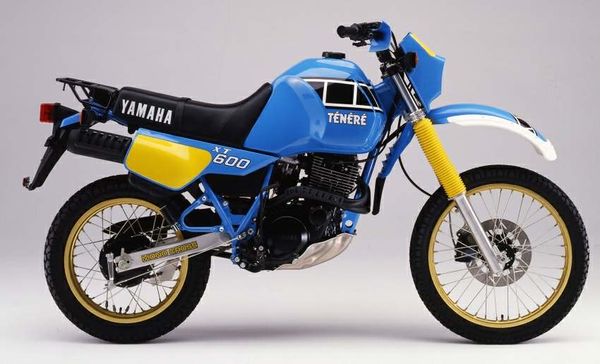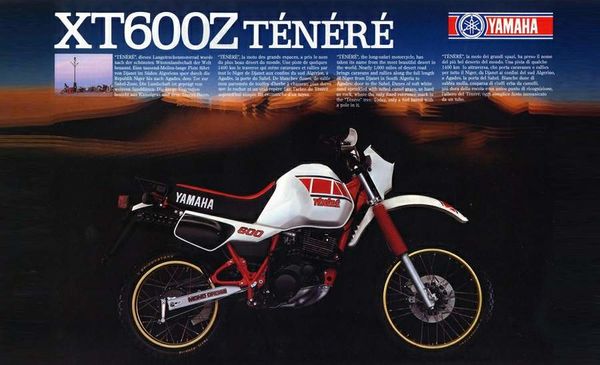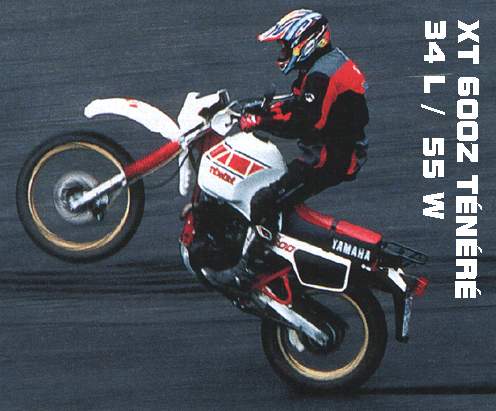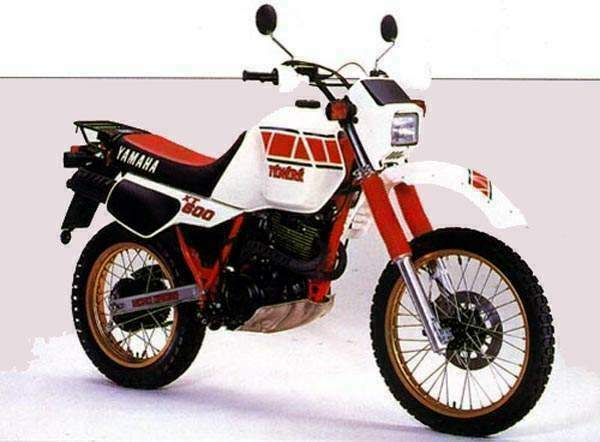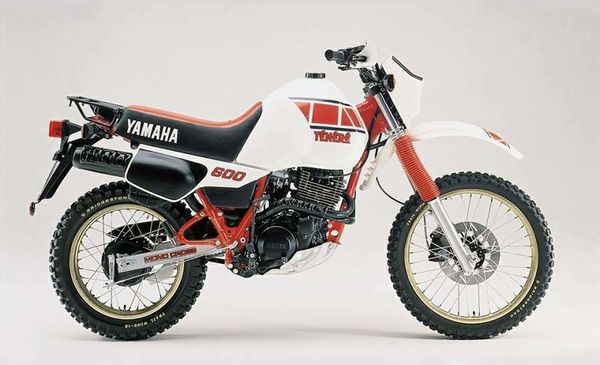Yamaha XT600Z
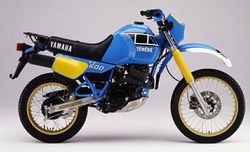 |
|
| Yamaha XT600 | |
| Manufacturer | |
|---|---|
| Also called | XT600 Ténéré (reduced effect), XT 600 Ténéré (reduced effect), XT600 2KF, XT 600 2KF, XT600 (reduced effect), XT 600 (reduced effect), XT600Z Ténéré (reduced effect), XT 600 Z Ténéré (reduced effect), XT600K (reduced effect), XT 600 K (reduced effect), XT600E (reduced effect), XT 600 E (reduced effect), XT600K, XT 600 K, XT600 Teneré, XT600Z Ténéré, XT600 Ténéré, XT600 Tenere, XT600E, XT 600 Z Ténéré, XT 600 Ténéré, XT 600 E, XT 600 |
| Production | 1983 - 1987 |
| Engine | Four stroke, single cylinder, SOHC, 4 valve |
| Compression ratio | 8.5:1 |
| Top Speed | 100 mph |
| Ignition | CDI |
| Battery | I2V/12Ah |
| Transmission | 5 Speed |
| Suspension | Front: Telescopic air assisted Rear: Monoshock swing arm |
| Brakes | Front: Single 260mm disc Rear: 150mm Drum |
| Front Tire | 3.00-21 |
| Rear Tire | 4.60-18 |
| Wheelbase | 1450 mm / 57.0 in |
| Seat Height | 890 mm / 35.0 in |
| Weight | 163 kg / 359.3 lbs (wet) |
| Oil Capacity | 2.5 Liters |
| Recommended Oil | Yamalube 10w-40 |
| Fuel Capacity | 28 Liters / 7.3 US gal |
| Related | Yamaha XT600 |
| Manuals | 1987 Yamaha XT600Z S Owners Manual 1988 Yamaha XT600 Z Owners Manual More Manuals |
It could reach a top speed of 100 mph.
Engine[edit | edit source]
The engine was a Air/oil cooled, cooled Four stroke, single cylinder, SOHC, 4 valve. The engine featured a 8.5:1 compression ratio.
Chassis[edit | edit source]
It came with a 3.00-21 front tire and a 4.60-18 rear tire. Stopping was achieved via Single 260mm disc in the front and a 150mm Drum in the rear. The front suspension was a Telescopic air assisted while the rear was equipped with a Monoshock swing arm. The XT600 Ténéré was fitted with a 28 Liters / 7.3 US gal fuel tank. The wheelbase was 1450 mm / 57.0 in long.
Photos[edit | edit source]
Overview[edit | edit source]
Yamaha XT 600 Ténéré
First generation: A new category XT600Z Ténéré with type code 34L is launched at Paris motorcycle show in October 1982. Its first color scheme became legendary: white with a red chain blocks as the Yamaha brand colors and blue with black chain blocks which was inspired by the color of the Yamaha Motor France (Sonauto/Gauloises) racing team. The first Ténére brought a lot of innovations to the Enduro segment, like a front disc brake when drum brakes were common, and a progressive mono cross suspension with aluminum swingarm that featured a long wheel travel of 235 mm. The front fork was a similar high-spec: 41mm, air assisted, with a stroke of 255 mm. The engine (a bore-up version of the XT 550) had 595 cc, lots of low-end power, and delivered 43 hp with a remarkable top speed of 160 km/h. There was no electric start and only a small head cowl but a huge fuel tank containing 30 liters !
Source yamaha-motor.de
Four-stroke single, 598 cc, SOHC four-vhlve with YDIS Front hydraulic disc brake New rising-rate Monocross suspension Large capacity fuel tank, heavy duty dual seat and sturdy luggage rack Dry sump lubrication with oil cooler and separate oil tank behind shock unit Air-assisted front fork with larger wheel travel
n 1983 Yamaha produced the first 600cc single
cylinder Enduro. The XT600Z Ténéré was named after the most difficult section of
the Paris-Dakar Rally. It started a new trend in Enduro bikes. With its large 28
litre fuel tank and long-travel (255/235mm) suspension, it no longer had much in
common with its predecessors, the XT500/XT550. It was in total contrast to the
XT500 with its small tank and modest spring travel.
This first model is commonly referred to as the 34L model in many countries.
It was the first time the MONOCROSS system, well known on motocross models, was
used on an Enduro bike. This transformed the heavy (165kg) Enduro in to a
perfect touring machine for motorcycle travellers. The engine produced 43HP with
a flexible but extremely strong performance at low engine speeds. The 34L model
Ténéré was successfully sold for 3 years from 1983 to 1985.
A few small modifications were made in 1985 and this is referred to as the 55W
model in some countries but this model is essentially the same as the 34L model.
Yamaha XT600 Ténéré, named after the brutal African desert that Paris-to-Dakar
rallyists must cross. The Ténéré chassis is basically the same as the stateside
XT's, with differences that are mainly cosmetic. Dominant is the 8-gal. gas
tank, big enough to allow the Ténéré almost 500 mi. between fill-ups. The
Ténéré's seat, because of the huge tank, is mounted more rearward, and it uses
softer foam. A nifty front fender, featuring cooling slats at the rear,
pop-riveted-on mud shrouds and a red-and-blue diagonal slash decal, keeps muck
off the rider. A sturdy luggage rack and plastic tool box take the place of the
U.S. model's vinyl tool pouch. Plastic handguards take the sting out of brushing
past bushes and help keep hands warm in cold weather.
Closer inspection reveals a myriad of smaller differences. The Ténéré gets a
three-tier oil cooler that is rubber-mounted to the left frame tube behind the
engine, and that even has its own little air shroud. The oil pickup line is
moved forward on the side-mounted oil tank to a less vulnerable position. The
headlight/number plate assembly is slightly larger, and the front turn signals
mount differently. The front brake's hydraulic line is routed over the number
plate instead of behind it, and the brake disc is slotted, not drilled as on the
U.S. model. Even the cam-snail chain adjusters are different.
Review
For once we can actually thank the French for
something. If the garlic crushers didn't take their pleasures in such a perverse
way we probably wouldn't have the Tènèrè at all. Their lust for breaking big
bikes over long distances combined with their centuries-old domination of most
of North Africa led to the development of the Paris-Dakar desert rally. With a
macho-macho image it wasn't long before tough guys in Europe started squealing
and stamping their little feet and demanding a replica.
The Tenure actually looks remarkably like the racers
that hammered across the North African moonscape this year. The Frogs even get a
version in the original Gauloises blue color scheme, but they obviously
considered this too bad for the English health, so we get ours in road racing
red and white.
The bike is named after a God-awful stretch of empty
desert deep in the Sahara, near the Chad/Nigeria border. Any machine that is
called after this little hell hole had better have some pretty big guts in it.
The Tènèrè has. At a push (so to speak) I reckon it could even complete the
Paris-Dakar course, though certainly not with moi on board. I toyed with the
idea of how it would have been on my Cairo to Cape Town jaunt, but although it
would have been the answer to a prayer on the fast, loose stretches, in the end
its weight and unpredictable starting (see later) would have counted it out,
despite the fact that it looks purpose built for the job.
This is all very wonderful of course, but has the
ability to survive the Sahara any relevance to biking in this green and crowded
land? The answer is definitely Yes, so long as you take it easy on the rough.
Gentle green laning is a breeze. The 595cc single slogs out great gobs of torque
from 2000rpm and will pull really strongly from about 2500. With a monstrous 10
inches of travel in the front forks and over nine in the Mono Cross, rising-rate
rear end you can bop serenely on, secure in the knowledge that a tweak on the
throttle at any revs will pull you effortlessly over any Rambler's Association
member you meet, with only the gentlest of shakes to the kidneys.
If you start going for it rather harder it all starts to get a little too
exciting. All that bulk and weight (for a trail bike) means that it needs plenty
of manhandling and footing to keep it going where you want it to. If you want to
take one on the dirt and go fast you had better start dreaming of wide open
spaces. Those hand protectors are purely for show, as if you intend mixing
closely with English hills and trees unless you are both good and strong you
might well end up ceiling-studying in your local hospital.
The XT600Z would undoubtedly make a great loose
track racer, as can be found in those spaces in Europe or America, as the power
and suspension would mean miles of safe high speed. In England though about the
only places you will find decent stretches of loose track are on what pass for
our roads, and this is perhaps where the Tènèrè best belongs.
It makes a triffic roadster for a trail bike. The
first trail bike feature I encountered was the lack of electric start: I found
this out after borrowing me dad's ladder and climbing up for a look. At five
foot nine (bigger than Napoleon anyway) I found a seat height of 35 inches
something of a strain, to say the least, but once on board the suspension sank
several inches, so that I could just touch the ground both sides. Eek, I'm
getting vertigo. To stave off the giddy feelings I concentrated on the
kickstarter, which is thankfully linked by a cable to one exhaust valve, thereby
giving simple decompression every kick.
Being a child of the electric start age, I regarded
all this with some mistrust but it does actually work. Sometimes it would fire
first kick or even when just pushing it round to get past TDC, but occasionally
it would take ten lunges or so before it caught, just at the point when I was
about to expire. It could just be my lack of technique but I never felt
completely confident that it would go although it always did in the end.
Once running, it warmed up quickly and would sit
duff-duffing with few of the big-single shakes thanks to the balance shaft
running off the crank. Once on the move I found out that the gearbox is meant to
be all things to all men (and women of course). The first three ratios are
fairly low and close together, for dirt donking, while the top two are spaced
wider apart. If this was purely a road bike that torque would ensure that you
only needed four ratios at the most, at least before the marketing department
got to it.
Yamaha claim 36.2 lb-ft at 5500rpm, and 43bhp at
6500 (though see "Powertrain"). This is a single bhp less than for its
stablemate, the XT600, which is pretty similar but with a smaller tank, and 5bhp
more than for its predecessor, the XT550. This is gained by a 3mill bore
increase and slightly larger carb choke diameters (to 27mm).
The head is a four valver, the valves operated by the normal chain-driven single
cam and rocker arms.
They draw from the twin carb arrangement found on
the XT550, with a slider carb operating at low revs and its CV companion cominq
in when larger amounts of fuel are required. YDIS, one carb asks. They should be
telling us. The system has been around for a couple of years now and seems to
work without hitch or surge, so appears to be at least a partial answer to the
two demands of performance and economy. Partial, because although the
performance is good the fuel consumption was around the mid-forties, about 10mpg
less than for the 550. Not very impressive.
The exhaust system was only partly impressive as
well. Twin pipes exit from the head and lead into a single, very efficient
silencer, well hidden behind the bodywork. It's a shame that they couldn't
finish it in something more durable as rust was already nibbling away at the
black paint and eating into the metal beneath. Never mind, Yamaha, it's not your
problem now: it's the problem of the punters who bought your product.
The black-painted engine is dry sump, as on the 550,
but instead of the oil residing in the frame tube it now has to commute rather
further, to an oil tank behind the left side panel. An oil cooler sits above the
left side crankcase to cure any heat problems, if there were any. It seemed
completely oiltight, except that it was weeping a little around the tappet
covers. Mind you, if I had been thrashed by the biking press so would I.
As I mentioned, there is absolutely loads of
suspension travel. Following a commuter over what claimed to be a road in
Kingston I watched him leave the saddle while I tracked easily over the worst of
the council mayhem. There is plenty of scope for adjustment in the single De
Carbon-type shock, but it copes perfectly if you just leave it alone. That meaty
box-section swinging arm running on taper roller bearings rounds off a really
excellent rear end.
You can also play around with the air in the front
forks, but they tend to dive, dive, dive whatever you do. Under hard
acceleration they wiggle and waggle as the weight rushes rearward and then they
twist and compress as you hit the front disc, leaving your nose closer to the
front monster mudguard than planned. During the two weeks of the test the forks
must have walked further than I did.
Throughout all this the Dunlop tires held on pretty
well, although you could make them squirm on the road and they clogged
hopelessly in the mud.
Despite all this the Tènèrè handles a treat on the road, whether on fast
sweepers or the infield stuff. Weighing 324 pounds with a gall of gas, you can
chuck the XT around in a way that would mean rupture or disaster on a bigger
four. I had this point confirmed when following a friendly GS850. While he was
busy scrubbing off speed prior to laying over 500 pounds down into the
roundabout I could chuck the Tènèrè in and boomerang out in some style, so long
as I remembered to get the power on early. If I forgot it would tend to flop a
bit, but apart from anything else it was great fun to flick it round bends and
let the motor slog you out of the turn and heave you off down the next straight.
It's redlined at seven grand, and will pull strongly towards it in any gear from
around the two-and-a-half mark, although as the needle gets past six it starts
to lose interest a bit. There can't be much future in over-revving a piston of
this size, so it's better just to hook up one and tramp on. The mid-range grunt
is pretty impressive for a 600 and gives good performance in the area you most
often use it. Sensible.
Top whack is a needle over the ton, but sustained
cruising is at about 70-80mph, with the engine turning at around the 5500rpm
mark. The mirrors will be blurred, but you can see behind you at all revs, but
not necessarily clearly enough to make out if cars have blue pointy bits on top.
The front disc makes a good job of wiping off the speed if you get too carried
away, and is backed up by a competent drum on the rear. Discs on trail bikes
seem compulsory now, but this one worked well on tarmac or mud with just
two-finger pressure, as so it should with only 324 pounds to stop.
So there you are, rolling along with that big single chugging away, suspension
smoothing out all the bumps and a monstrous six-and-a-half gallon tank meaning
you don't have to stop all day. Why then is that contented smile slowly
faltering and fading after only about 50 miles? Because your bum aches.
The riding position sits you upright in the saddle,
with wide, high bars and forward pegs, and the saddle starts to compress and get
uncomfortable. This is all the more irritating since if they had made the perch
firmer and more compact they could have lowered that intimidating seat height.
The Japs are funny chaps.
The rear footrests get a nice frame loop to
themselves, but the rear seat got a thumbs down for comfort. It would probably
have been longer if they had not included a very useful little black rack
which is bigger than you find on some BMWs.
The twiddly bits on the ends of the bars are fair
enough, but I was fascinated to see that the light switches are both on the left
cluster, so you can turn off the excellent 60/55W quartz headlight instead of
dimming it. I thought this complaint went out years ago, as did non lockable
filler caps, but they are both here. The plastic filler cap means that you can
leave over 10 pounds worth of fuel lying around unprotected. How naff.
The fuel tank, even with a placcy filler, is the big
styling success of this bike, and there is no denying the handsome lines of the
brute. The knee cut-outs keep your knees together girls before flaring out
towards the forks, so is not obtrusive at all. Mind you, you remember it's there
when you are about to drop it on the dirt. The figure of £229 to replace it
should concentrate your mind wonderfully. It's the big crowd puller though, that
makes people stop and come and ask you about it, and kids run out
at traffic lights, risking death by artic, to get a
better look. Even if they don't recognise what it is supposed to be at least
they notice it.
At the moment Yamaha have the Paris-Dakar scene to
themselves, although it looks like being the next area of development for big
singles with machines on the way from several manufacturers, including Honda and
Suzuki.
Until they appear the Tènèrè stands tall on its own
(about 40 inches), and it's a fine machine. It proved to be an excellent
commuter, getting me to work in an unusually relaxed state. In fact it can do
just about anything you want it to, bar very high, very high mileage trips, and
gives the impression that it could survive just about anything that passes under
its wheels. At £2015 it's not cheap by any means, but what I most liked about it
was its ability to back up its mouth. It looks like it could cross the whole
continent of Africa, with its bad tarmac, dirt and sand, and I reckon it could.
You can't ask more than that.
Source Sport Rider
| Make Model | Yamaha XT 600Z Ténéré |
|---|---|
| Year | 1983 - 84 |
| Engine Type | Four stroke, single cylinder, SOHC, 4 valve |
| Displacement | 595 cc / 36.3 cu-in |
| Bore X Stroke | 95 x 84 mm |
| Cooling System | Air/oil cooled, |
| Compression | 8.5:1 |
| Oil Capacity | 2.5 Liters |
| Induction | 27mm Dual stage Teikei Y 27 PV carburetor |
| Ignition | CDI |
| Battery | I2V/12Ah |
| Starting | Kick |
| Max Power | 46 hp / 34 kW @ 6000 rpm |
| Max Power Rear Tire | 38.0 hp @ 6000 rpm |
| Max Torque | 4.5 kgf-m / 51 Nm @ 5750 rpm |
| Transmission | 5 Speed |
| Final Drive | Chain |
| Front Suspension | Telescopic air assisted |
| Front Wheel Travel | 255 mm / 10.0 in |
| Rear Suspension | Monoshock swing arm |
| Rear Wheel Travel | 236 mm / 9.2 in |
| Front Brakes | Single 260mm disc |
| Rear Brakes | 150mm Drum |
| Front Tire | 3.00-21 |
| Rear Tire | 4.60-18 |
| Dimensions | Length 2210 mm / 87.0 in Width 890 mm / 35.0 in |
| Wheelbase | 1450 mm / 57.0 in |
| Seat Height | 890 mm / 35.0 in |
| Wet Weight | 163 kg / 359.3 lbs |
| Fuel Capacity | 28 Liters / 7.3 US gal |
| Consumption Average | 59 mpg |
| Standing ¼ Mile | 14.4 sec |
| Top Speed | 100 mph |
